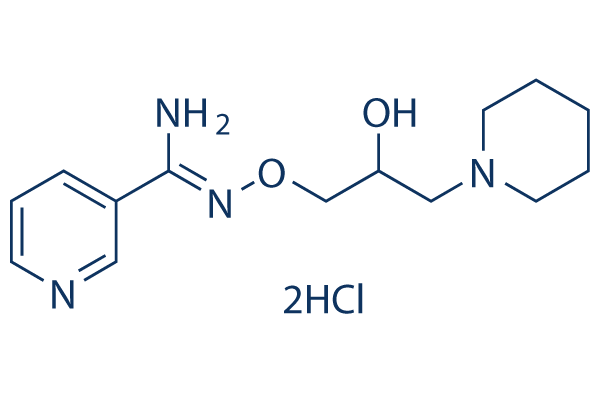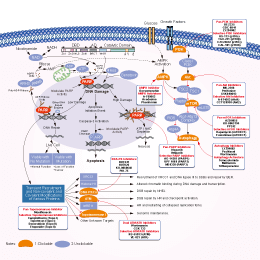
- Bioactive Compounds
- By Signaling Pathways
- PI3K/Akt/mTOR
- Epigenetics
- Methylation
- Immunology & Inflammation
- Protein Tyrosine Kinase
- Angiogenesis
- Apoptosis
- Autophagy
- ER stress & UPR
- JAK/STAT
- MAPK
- Cytoskeletal Signaling
- Cell Cycle
- TGF-beta/Smad
- DNA Damage/DNA Repair
- Compound Libraries
- Popular Compound Libraries
- Customize Library
- Clinical and FDA-approved Related
- Bioactive Compound Libraries
- Inhibitor Related
- Natural Product Related
- Metabolism Related
- Cell Death Related
- By Signaling Pathway
- By Disease
- Anti-infection and Antiviral Related
- Neuronal and Immunology Related
- Fragment and Covalent Related
- FDA-approved Drug Library
- FDA-approved & Passed Phase I Drug Library
- Preclinical/Clinical Compound Library
- Bioactive Compound Library-I
- Bioactive Compound Library-Ⅱ
- Kinase Inhibitor Library
- Express-Pick Library
- Natural Product Library
- Human Endogenous Metabolite Compound Library
- Alkaloid Compound LibraryNew
- Angiogenesis Related compound Library
- Anti-Aging Compound Library
- Anti-alzheimer Disease Compound Library
- Antibiotics compound Library
- Anti-cancer Compound Library
- Anti-cancer Compound Library-Ⅱ
- Anti-cancer Metabolism Compound Library
- Anti-Cardiovascular Disease Compound Library
- Anti-diabetic Compound Library
- Anti-infection Compound Library
- Antioxidant Compound Library
- Anti-parasitic Compound Library
- Antiviral Compound Library
- Apoptosis Compound Library
- Autophagy Compound Library
- Calcium Channel Blocker LibraryNew
- Cambridge Cancer Compound Library
- Carbohydrate Metabolism Compound LibraryNew
- Cell Cycle compound library
- CNS-Penetrant Compound Library
- Covalent Inhibitor Library
- Cytokine Inhibitor LibraryNew
- Cytoskeletal Signaling Pathway Compound Library
- DNA Damage/DNA Repair compound Library
- Drug-like Compound Library
- Endoplasmic Reticulum Stress Compound Library
- Epigenetics Compound Library
- Exosome Secretion Related Compound LibraryNew
- FDA-approved Anticancer Drug LibraryNew
- Ferroptosis Compound Library
- Flavonoid Compound Library
- Fragment Library
- Glutamine Metabolism Compound Library
- Glycolysis Compound Library
- GPCR Compound Library
- Gut Microbial Metabolite Library
- HIF-1 Signaling Pathway Compound Library
- Highly Selective Inhibitor Library
- Histone modification compound library
- HTS Library for Drug Discovery
- Human Hormone Related Compound LibraryNew
- Human Transcription Factor Compound LibraryNew
- Immunology/Inflammation Compound Library
- Inhibitor Library
- Ion Channel Ligand Library
- JAK/STAT compound library
- Lipid Metabolism Compound LibraryNew
- Macrocyclic Compound Library
- MAPK Inhibitor Library
- Medicine Food Homology Compound Library
- Metabolism Compound Library
- Methylation Compound Library
- Mouse Metabolite Compound LibraryNew
- Natural Organic Compound Library
- Neuronal Signaling Compound Library
- NF-κB Signaling Compound Library
- Nucleoside Analogue Library
- Obesity Compound Library
- Oxidative Stress Compound LibraryNew
- Plant Extract Library
- Phenotypic Screening Library
- PI3K/Akt Inhibitor Library
- Protease Inhibitor Library
- Protein-protein Interaction Inhibitor Library
- Pyroptosis Compound Library
- Small Molecule Immuno-Oncology Compound Library
- Mitochondria-Targeted Compound LibraryNew
- Stem Cell Differentiation Compound LibraryNew
- Stem Cell Signaling Compound Library
- Natural Phenol Compound LibraryNew
- Natural Terpenoid Compound LibraryNew
- TGF-beta/Smad compound library
- Traditional Chinese Medicine Library
- Tyrosine Kinase Inhibitor Library
- Ubiquitination Compound Library
-
Cherry Picking
You can personalize your library with chemicals from within Selleck's inventory. Build the right library for your research endeavors by choosing from compounds in all of our available libraries.
Please contact us at info@selleckchem.com to customize your library.
You could select:
- Antibodies
- Bioreagents
- qPCR
- 2x SYBR Green qPCR Master Mix
- 2x SYBR Green qPCR Master Mix(Low ROX)
- 2x SYBR Green qPCR Master Mix(High ROX)
- Protein Assay
- Protein A/G Magnetic Beads for IP
- Anti-Flag magnetic beads
- Anti-Flag Affinity Gel
- Anti-Myc magnetic beads
- Anti-HA magnetic beads
- Poly DYKDDDDK Tag Peptide lyophilized powder
- Protease Inhibitor Cocktail
- Protease Inhibitor Cocktail (EDTA-Free, 100X in DMSO)
- Phosphatase Inhibitor Cocktail (2 Tubes, 100X)
- Cell Biology
- Cell Counting Kit-8 (CCK-8)
- Animal Experiment
- Mouse Direct PCR Kit (For Genotyping)
- New Products
- Contact Us
research use only
BGP-15 2HCl PARP inhibitor
BGP-15, is a nicotinic amidoxime derivative with PARP inhibitory activity. It has been demonstrated that BGP-15 protects against ischemia-reperfusion injury.

Chemical Structure
Molecular Weight: 351.27
Purity & Quality Control
Related Products
| Related Targets | PARP1 PARP2 PARP3 Tankyrase-1 Tankyrase-2 PARP14 PARP7 TNKS1 TNKS2 | Click to Expand |
|---|---|---|
| Related Products | XAV-939 Veliparib (ABT-888) PJ34 HCl AG-14361 Iniparib (BSI-201) A-966492 G007-LK UPF 1069 AZD2461 Pamiparib ME0328 3-Aminobenzamide NMS-P118 Stenoparib (E7449) NVP-TNKS656 WIKI4 Benzamide NU1025 BYK204165 Fluzoparib (SHR-3162) Picolinamide | Click to Expand |
| Related Compound Libraries | FDA-approved Drug Library Natural Product Library Apoptosis Compound Library DNA Damage/DNA Repair compound Library Cell Cycle compound library | Click to Expand |
Signaling Pathway
Mechanism of Action
| Targets |
|
|---|
In vitro |
||||
| In vitro | The hydroxylamine derivative BGP-15 is a coinducer of HSP72 in vitro, but only in the presence of cotreatment with heat and had no effect on HSP90 levels[3]. BGP-15 (200 μM) prevented the imatinib mesylate-induced oxidative damages, attenuated the depletion of high-energy phosphates, altered the signaling effect of imatinib mesylate by preventing p38 MAP kinase and JNK activation, and induced the phosphorylation of Akt and GSK-3beta. The suppressive effect of BGP-15 on p38 and JNK activation could be significant because these kinases contribute to the cell death and inflammation in the isolated perfused heart[4]. | |||
|---|---|---|---|---|
| Cell Research | Cell lines | Human tumor cell lines A549, HCT-15, HCT-116, and Du-145 | ||
| Concentrations | 10, 30, 100 μg/mL | |||
| Incubation Time | 3 days | |||
| Method | Human tumor cell lines A549, HCT-15, HCT-116, and Du-145 were maintained in RPMI 1640 medium supplemented with 10% FCS in humidified air containing 5% CO2. For in vitro cytotoxicity assays, 5×103 to 5×104 cells were plated into the wells of 96-well plates in 100 μL culture medium. On the following day, cells were exposed to BGP-15 (10, 30, 100 μg/mL) and to a series of concentrations of cisplatin either by itself or in combination. Cultures were incubated in a total volume of 200 μL for 3 more days at 37°. Samples were prepared in duplicates or triplicates. Cell growth was evaluated by MTT or SRB assays. Growth inhibition curves were calculated. |
|||
In Vivo |
||
| In vivo | BGP-15 improves cardiac function and reduces arrhythmic episodes in two independent mouse models, which progressively develop HF and AF[2]. BGP-15 administered in 100-200 mg/kg oral doses shortly before cisplatin treatment either prevented or significantly inhibited the development of cisplatin-induced acute renal failure. BGP-15 had a significant effect on the antioxidant status of kidney during cisplatin-induced nephrotoxicity. It elevated the decreased glutathione and catalase levels, but did not affect SOD activity. BGP-15 treatment decreased the cisplatin-caused ROS production and restored the level of high energy phosphate intermediates. While BGP-15 protected against cisplatin-induced nephrotoxicity, it did not reduce the antitumor efficacy of this cytostatic agent. BGP-15 increased the survival of cisplatin-treated P-388 leukemia bearing mice. BGP-15 inhibits the cisplatin-induced poly-ADP-ribosylation in the kidney. At the same time, BGP-15 restored the cisplatin-induced disturbance in energy metabolism and preserved the ATP level in the protected tissue[1]. | |
|---|---|---|
| Animal Research | Animal Models | NMRI CV1 mice, BD2F1 mice and Wistar rats |
| Dosages | 100, 200 mg/kg | |
| Administration | p.o. | |
References |
|
Chemical Information
| Molecular Weight | 351.27 | Formula | C14H22N4O2.2HCl |
| CAS No. | 66611-37-8 | SDF | Download SDF |
| Synonyms | N/A | ||
| Smiles | C1CCN(CC1)CC(CON=C(C2=CN=CC=C2)N)O.Cl.Cl | ||
Storage and Stability
| Storage (From the date of receipt) | |||
|
In vitro |
DMSO : 70 mg/mL ( (199.27 mM) Moisture-absorbing DMSO reduces solubility. Please use fresh DMSO.) Water : 70 mg/mL Ethanol : 70 mg/mL |
Molecular Weight Calculator |
|
In vivo Add solvents to the product individually and in order. |
In vivo Formulation Calculator |
|||||
Preparing Stock Solutions
Molarity Calculator
In vivo Formulation Calculator (Clear solution)
Step 1: Enter information below (Recommended: An additional animal making an allowance for loss during the experiment)
mg/kg
g
μL
Step 2: Enter the in vivo formulation (This is only the calculator, not formulation. Please contact us first if there is no in vivo formulation at the solubility Section.)
% DMSO
%
% Tween 80
% ddH2O
%DMSO
%
Calculation results:
Working concentration: mg/ml;
Method for preparing DMSO master liquid: mg drug pre-dissolved in μL DMSO ( Master liquid concentration mg/mL, Please contact us first if the concentration exceeds the DMSO solubility of the batch of drug. )
Method for preparing in vivo formulation: Take μL DMSO master liquid, next addμL PEG300, mix and clarify, next addμL Tween 80, mix and clarify, next add μL ddH2O, mix and clarify.
Method for preparing in vivo formulation: Take μL DMSO master liquid, next add μL Corn oil, mix and clarify.
Note: 1. Please make sure the liquid is clear before adding the next solvent.
2. Be sure to add the solvent(s) in order. You must ensure that the solution obtained, in the previous addition, is a clear solution before proceeding to add the next solvent. Physical methods such
as vortex, ultrasound or hot water bath can be used to aid dissolving.
Tech Support
Answers to questions you may have can be found in the inhibitor handling instructions. Topics include how to prepare stock solutions, how to store inhibitors, and issues that need special attention for cell-based assays and animal experiments.
Tel: +1-832-582-8158 Ext:3
If you have any other enquiries, please leave a message.
* Indicates a Required Field






































